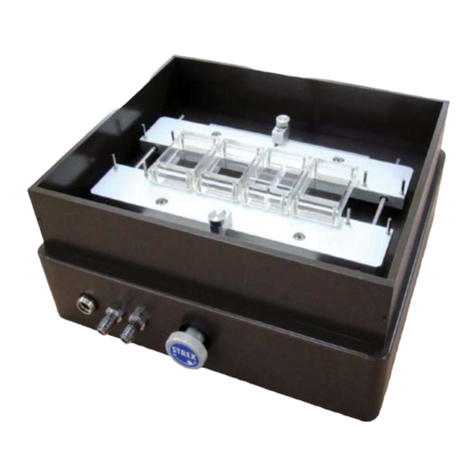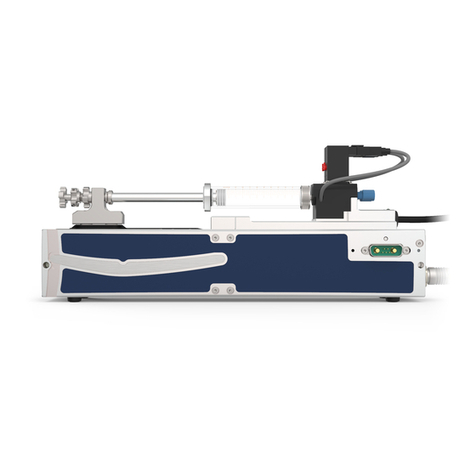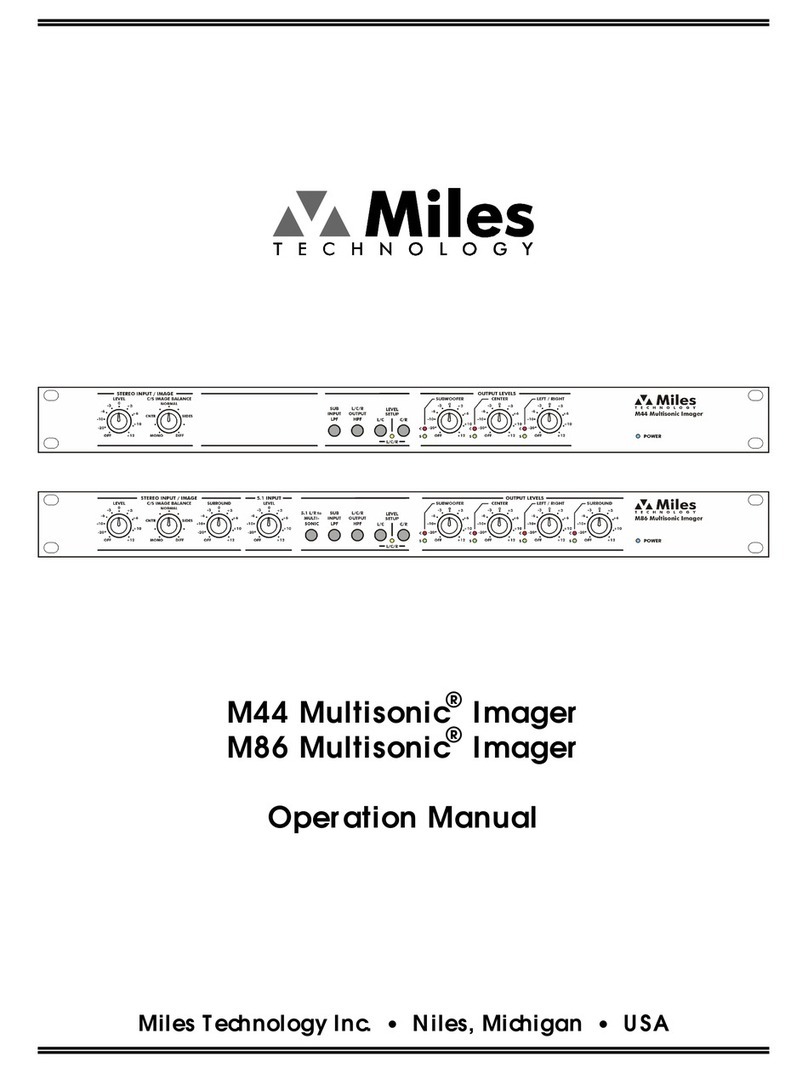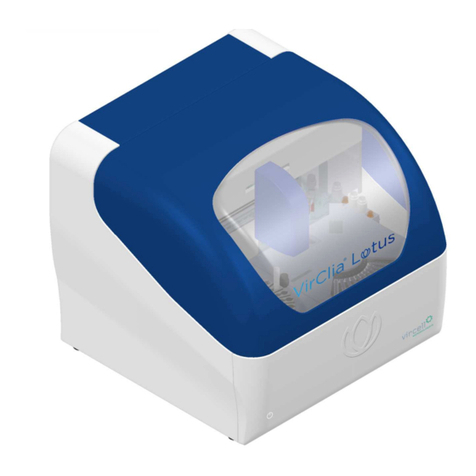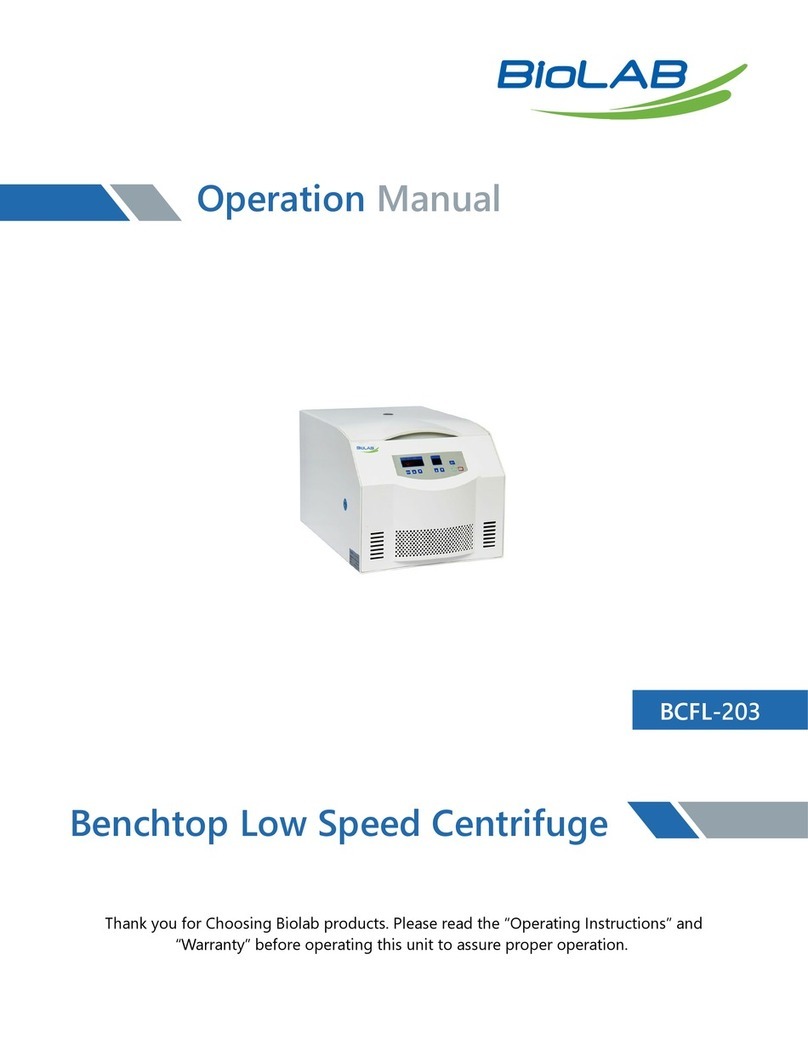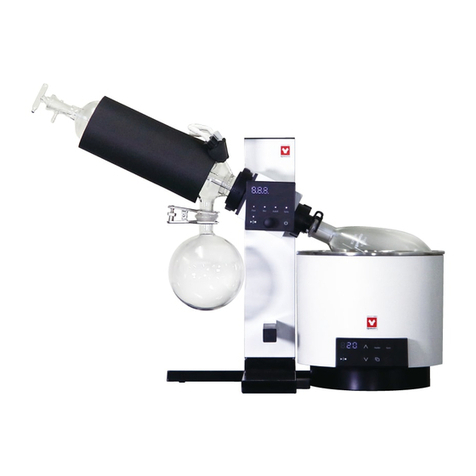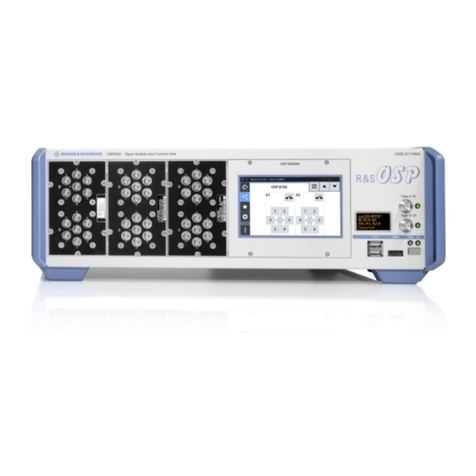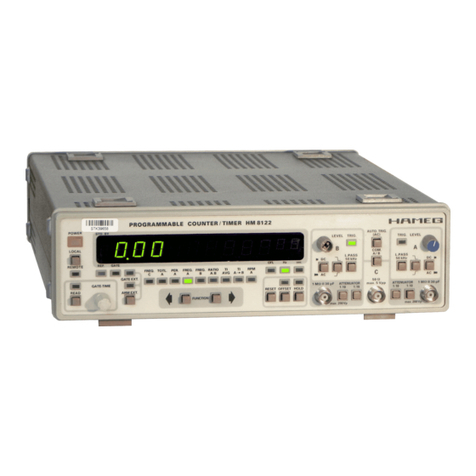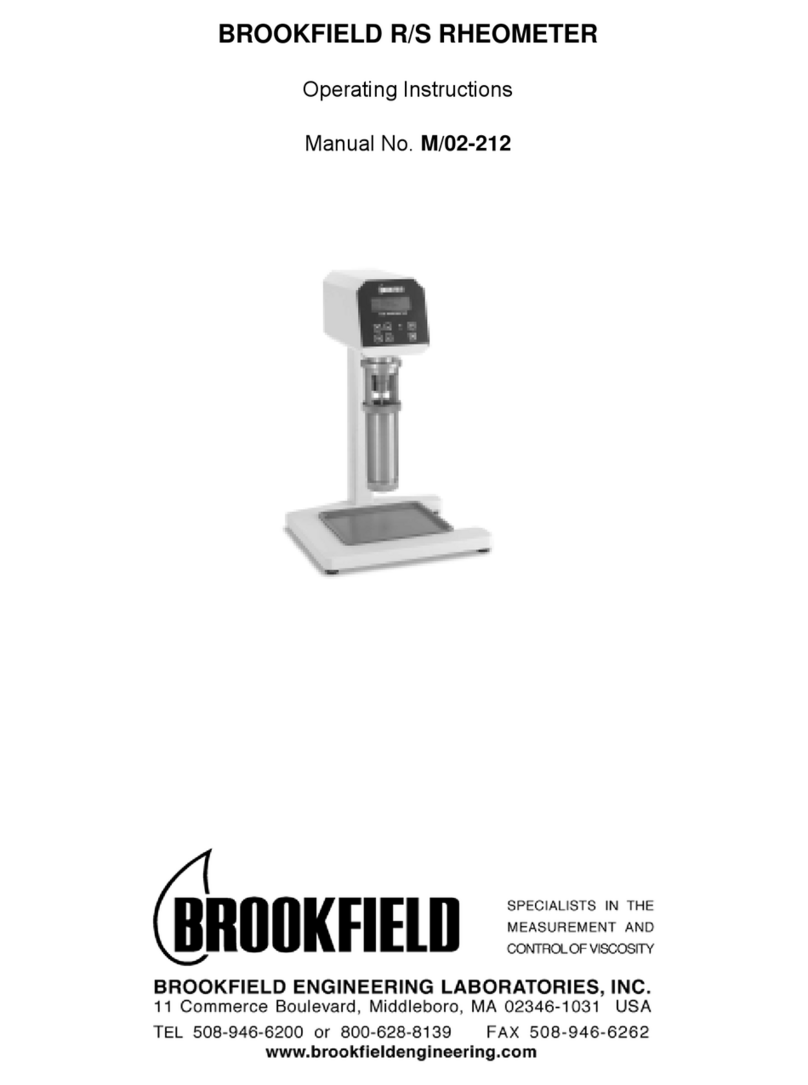strex STB-140-10 User manual

Cell Stretching System
Model # STB-140-10
User Manual
Strex US Office
100600 Carroll Canyon Rd.,
Suite 100
San Diego, CA 92131
Email: [email protected]
www.strexcell.com

2
Contents
Section 1: Main Components……………………………..3
Stretch Unit……………………………………………...3
Control Unit Front Panel……………………………….4
Control Unit Back Panel……………………………….4
Silicone Strain Chamber……………………………….5
Section 2: Use of the Cell Strain Instrument…………..6
Preparation of Cell Strain Instrument………………...6
System Operation………………………………………6
Culturing Cells in the Silicone Chambers…...……….7
Preparation of Silicone Chambers…...……………….8
Section 3: Strain Parameters………………………........10
Section 4: FAQ……………………………………………...11
Section 5: References……………………………………..13
Section 6: Safety Instructions and Precautions……...15
Section 7: Warranty………………………………………..19

Section 1: Main Components
Stretch Unit
System Coolant Inlet and Outlet Valves:
Be sure to supply cool water when in operation.
Failure to do so may lead to overheating
inside the incubator or motor burnout.
Chamber Length Adjusting Knob:
Use the knob to adjust the distance of
chamber brackets to maintain tension on the
chamber. The bottom of the chamber should
be taut.
Connectors:
Use Connector Cable to connect
Control Unit to Stretch Unit.
Alignment Pins:
Holds Strain Chamber Brackets in place.
Chamber Brackets:
Each chamber is mounted on four
pins, two pins on each bracket.
Mounting Stage:
Brackets sit on top of the
stage.
3

Control Unit Front Panel
Control Unit Back Panel
Main Power Switch
Start and Stop Button:
Use to start or stop the stretching
action.
Control Connector:
This cable supplies electricity from the
Control Unit to the Stretch Unit.
Fuse case cover
Power Cable Outlet for 110 Volts:
Use the Power Cable to connect the
Control Unit to a power source.
Strain Ratio:
Use upper and lower buttons to
increase and decrease stretch
ratio.
Strain Frequency Selector:
Use upper and lower buttons to adjust cycle
frequency.
Water Pump Switch (Manual Override):
Use to turn on and off the pump that circulates
water to cool the motor. Note: Water Pump will
automatically turn on when temperature sensors
reach over 40 C.
System Coolant Inlet & Outlet
Valves: Be sure to supply cool
water when in operation. Failure to
do so may lead to overheating
inside the incubator or motor
burnout.
Reservoir Coolant Inlet & Outlet
Valves: Attach a large flask or similar
type of reservoir filled with cold
water.
4

42mm
10mm
5
29mm
4 places for hooks holes
51mm
35mm
Silicone Strain Chambers (ST-CH-10)
Chamber Dimensions
32mm x 32mm x 10mm

6
Section 2: Use of the Cell Strain Instrument
Preparation of the Cell Strain Instrument
Before using the Cell Strain Instrument, sterilize the unit —especially the chamber
mounting area—using ethanol-immersed swabs.
System Operation
The STREX Cell Strain System needs to be water cooled when in operation.
Without cooling, the maximum run time for the continuous operation of the
motor is only 10 minutes. For longer operation, water cooling is essential. Also,
please note that, when operating the unit in an incubator, the temperature inside the
unit will be elevated so it is particularly important to ensure the cooling system is
employed in this environment.
►Set up the Strain and Control Unit
1. Set up the cooling system by using the Connector Cable. The Connector Cable supplies
electricity and cold water from the Control Unit to the Stretch Unit. One end of the Cable
has 3 plugs of which 2 are identical metal plugs. This end of the Cable attaches to the
front of the Stretch Unit. The 2 identical metal plugs are plugged into the System Coolant
Inlet and Outlet Valves (see Section 1). To release the metal plugs from the Stretch Unit,
push backward on the outer metal rings around the valves. The single, larger black plug
supplies electricity to the Stretch Unit –this plug has to be in the correct orientation to fit
properly. Improper orientation will break the outlet.
The other end of the Connector Cable has 2 exposed latex tubes which fit onto the
System Coolant Inlet and Outlet Valves on the back panel of the Control Unit. The
Cable’s square shaped plug fits the motor outlet just above the coolant valves.
To circulate cool water throughout the system, use latex tubing to attach a large
reservoir of cold water to the Reservoir Coolant Inlet and Outlet Valves on the back
panel of the Control Unit. The water in the reservoir can be kept cool by placing the
reservoir on ice.
2. Connect the Control Unit to a 110 Volts power source by the Power Cable.
3. Turn on the Main Power Switch but keep the Water Pump Switch off. The Water Pump
automatically turns on and off based on the temperature of the unit.
4. Press the START button to ensure that the strain chamber bracket moves correctly. The
Start Button light will flash when the instrument is stretching.
5. Press the STOP button to ensure that the strain chamber bracket stops moving. The
STOP Button will light up.

7
6. Make sure that the water pump is pumping water from the reservoir and through
the Control and Stretch Unit.
7. Turn off Main Power and Water Pump Switches.
►Start Cell Stretching
1. The Power Switch must be OFF to freely rotate the Chamber Length
Adjustment Knob. Silicone chambers containing cultured cells are attached to the
Stretch Unit by inserting the 4 pins into the corners of the chamber. Rotate the
Adjustment Knob clockwise until the bottom of the chamber is taut.
2. Select the stretch parameters by changing the Stretch Pattern Buttons. Refer to
Section 3 for stretch parameters.
3. Do not change the Strain Ratio or Strain Frequency Selector Buttons
during the operation of a stretch cycle. Press the Stop Button and wait
for the last cycle to complete and the chamber returns to its starting
position before changing stretch parameters. Changing parameters during
a stretch cycle may damage the motors.
4. Push the Start Button to start the stretch unit.
5. After 5 minutes, stop the stretching and check the condition of the cells. If the cells
have not detached, proceed with your experiment. If the cells are detached, the
adhesion matrix coating was probably insufficient. Recoat the chambers.
Culturing Cells in the Silicone Chambers
1. Seed cells at the appropriate concentrations in the freshly coated chambers.
Important: It is critical to not over expose the cells to dissociation enzymes. Cells
should be treated in the same manner (type, concentration of enzyme,
temperature, and exposure time) for all experiments.
Important: Cells should not be cultured at a high cell density in the chambers. For
example, epithelial cells often form a cell-sheet and the cell-cell adhesion seems
to be stronger than a cell-surface adhesion. When this happens cells may detach
from the chamber. Additionally, cultures that are grown over a week in the
chambers may detach.
2. After overnight incubation, inspect cells under a microscope to ensure that they
adhered to the chamber.

8
Preparation of Silicone Chambers
Before using the chambers, they should be sterilized then coated with a cell adhesion
matrix. The coating procedures below can be adapted for use with other matrices,
such as Elastin, Pronectin, and Laminin.
Sterilize chambers in an autoclave for 20 minutes at 120°C.The silicone chambers can
withstand temperatures up to 180°C. Use of an autoclave is preferable. However, if
an autoclave is not available, the chambers may be sterilized by submerging in 70%
ethanol, rinsing with water, then drying in a sterile environment.
Place the sterile silicone chambers in a Petri dish in preparation for coating.
►Fibronectin Coating
Preparation of Fibronectin solution:
1. Dilute human or bovine Fibronectin to a final
concentration of 50 to 100 ug/ml in Phosphate Buffered
Saline (PBS).
Coating with Fibronectin solution:
1. Pour 3 ml of the Fibronectin solution into each strain
chamber.
2. Incubate at 37oC for more than 30 minutes.
3. Aspirate the fibronectin solution. If coating is successful,
water will not be repelled after removing the fibronectin
solution.
4. The liquid solution can be used to coat 3 or 4 chambers
before discarding.
PBS(per liter):
NaCl 8.00 g
KCl 0.20 g
Na2HP4(anhyd.) 1.15 g
KH2PO4(anhyd.) 0.20 g
Note: Dulbecco’s PBS in powder form
for tissue culture applications is also
commercially available.

9
►Gelatin Coating
Preparation of gelatin solution:
1. Add gelatin powder to PBS at a concentration of 2%.
2. Autoclave the mixture to dissolve and sterilize.
Coating with gelatin solution:
1. Pour 3 ml of the gelatin solution into each strain chamber.
2. Incubate at 37oC for more than 30 minutes.
3. Aspirate the gelatin solution. If coating is successful, water will not be repelled
after removing the gelatin solution.
4. The liquid solution can be used to coat 3 or 4 chambers before discarding.
►Collagen Coating (Cellmatrix 1-C, P, Type 3 or 4)
Preparation of collagen solution:
1. Combine 1 part collagen to 10 parts HCL, pH 3, in a
sterile tube.
Coating with collagen solution:
1. Coat chamber with a thin layer.
2. Aspirate excess.
3. Dry in biological safety cabinet at 25°C or
below. The chamber can be stored at the
same temperature.
4. Wash the chamber twice with culture medium.
5. If coating is successful, water will not be
repelled.
The PDMS (silicone) chambers
are very hydrophobic with two
methyl-bases on the surface.
Cells adhere to the fibronectin
or collagen coated chambers
via integrins. This form of cell
adhesion is very different
compared to attachment of
cells to plastic or glass dishes
where the surface of plastic or
glass is charged, resulting in
non-specific binding.
If the cells are having difficulty
attaching to the coated
chamber or easily detached
upon stretching, treat the
stretch chamber with a higher
concentration of fibronectin or
collagen, for overnight.

10
Section 3: Strain Parameters (Stretch)
Digit Degree of stretch Distance
02% 0.64 mm
14% 1.28 mm
25% 1.6 mm
38% 2.56 mm
410% 3.20 mm
512% 3.84 mm
615% 4.80 mm
720% 6.40 mm
LEFT Digit: Strain Frequency Selector
Digit Program Description*
060 Cycles/min
(1 Hz)
Sine wave
Stretch 0.5 sec –contract 0.5 sec -
repeat
130 cycles/minute
(0.5 Hz)
Sine wave
Stretch 1 sec –contract 1 sec -
repeat
215 cycles/minute
(0.25 Hz)
Sine wave
Stretch 2 sec
–contract 2 sec -
repeat
310 cycles/minute
Sine wave
Stretch 3 sec
–contract 3 sec -
repeat
420 cycles/minute
Square wave
Hold 0.5 sec –stretch 1 sec- hold
0.5 sec
- contract 1 sec - repeat
510 cycles/minute
Square wave
Hold 2 sec –stretch 1 sec –hold 2
sec
- contract 1 sec- repeat
61 cycle/minute
Square wave
Hold 29 sec –stretch 1 sec –
hold 29 sec –contract 1 sec -
repeat
7
Static
Stretch 1 sec
–hold indefinitely
RIGHT Digit: Strain Ratio

11
Section 4: FAQ
Q1: What are the characteristics of the silicone chamber?
A1: The strain chamber is made from silicone elastomer consisting of
polydiethylsiloxane as its major component. The chamber surface is strongly
hydrophobic and cells have difficulty attaching to it; therefore, the chamber surface
should be coated with an extra-cellular matrix like fibronectin, collagen, laminin, or
gelatin before cultivation.
Q2: Cell attachment on the stretch chamber is not consistent.
A2: There may be wrinkles or bubbles on the bottom surface of the strain chamber
when seeding cells. Although the chamber is carefully made not to have
wrinkles on it, some products might have little wrinkles due to its thin structure. We
recommend the following steps. Place a small volume of ethanol in a Petri
dish that is large enough to hold the strain chamber. Gently place the chamber in the
culture dish starting at one edge and moving toward the opposite edge of the chamber
to remove air bubbles between the dish and chamber. Allow the ethanol to evaporate
before spreading your cell suspension in the chamber.
Q3. Cell attachment on the stretch chamber was confirmed by microscopy. But the
cells detached from the chamber surface after stretching the cells.
A3: Try seeding your chambers at a lower concentration of cells. Over-confluent cells
generally adhere to neighboring cells rather than to the base matrix (dish surface).
When an excess amount of cells are put in a culture dish, the cells connect to each
other after growth. Such behavior of the over-confluent cells, which are often observed
in normal culture dishes, is even worse in the strain chamber.
A second possibility for cell detachment is that the cells were damaged by enzyme
treatment such as trypsin before seeding. The damaged cells sometime attach to
surfaces by non-specific binding and are not specifically bound to the extra-cellular
matrix coating on the chamber; therefore, time, concentration, and temperature for the
enzyme treatment should be optimized to reduce cell damage.
A third possibility is insufficient coating of the chamber preventing the cells from
attaching to the chamber. Longer coating time is recommended. Some researchers
coated the chamber with two or more kinds of the extra-cellular matrix materials to
increase binding effectiveness.

12
Q4: How long can cells be stretched?
A4: The duration depends on cell strain and condition. In general, two weeks
cultivation in the incubator is possible with culture media changes every 2-3 days. It
is also important to monitor reservoir coolant for the instrument motor. Insufficient
amount of the cooling water may increase the temperature of the motor resulting in
killing of cells and /or burning out the motor.
Q5: How can I obtain protein or mRNA samples from the cells attached to the silicone
membrane?
A5: (1) Proteins for Western blotting: Wash the cels once with PBS. Add SDS-
PAGE sample loading dye directly into the chamber, and collect the cell extract by
using a cell scraper.
(2)Proteins for Immunoprecipitation: Wash the cells once with PBS. Add cell extract
buffer directly into the chamber, and collect the cell extract by using a cell scraper.
(3)RNA: Wash the cells once with PBS (for RNA preparation). Add RNA extraction
buffer directly into the chamber, and collect the cell extract by using a cell scraper.
Q6: I want to use recombinant cells for an experiment.
A6: Direct transfection of cells in the strain chamber may be possible. However,
transfection itself may damage the cells, which may make getting clear image data
difficult. We recommend performing the transfection in a normal culture dish then
transferring the recombinant cells into the strain chamber.
Q7: Cells seem to be crowded in the center of the chamber instead of being uniformly
distributed throughout the chamber.
A7: Vibration from the incubator may disrupt the distribution of the cells. We
recommend gently rocking the chamber 15 minutes after seeding your cells.

13
Section 5:
References
1. Effects of repetitive stretch stimulation on neonatal rat cardiocytes in vitro, K. Kada, K. Yasui, K. Naruse, and J.
Toyama. Environmental Medicine, 40: 69-72, 1996.
2. Inhibitory action of repeated stretch stimulation on apoptosis in neonatal rat cardiocytes., K. Yasui, H.
Shimano, K. Kada, K. Naruse, and J. Toyama. Environmental Medicine, 40: 175-177, 1996.
3. Mechanosensitive ion channels: Single channels vs. Whole cell activities, M. Sokabe, K. Nunogaki and K.
Naruse. Progress in Cell Research, 6:139-149, 1997.
4. Up-regulation of integrin beta3 expression by cyclic stretch in human umbilical endothelial cells., M. Suzuki, K.
Naruse, Y. Asano, T. Okamoto, N, Nishikimi, T. Sakurai, Y. Nimura, and M. Sokabe. Biophys. Biochem. Res.Com.,
239:372-376, 1997.
5. Mechanotransduction and intracellular signalingmechanisms of stretch-induced remodeling in endothelial cells,
Masahiro Sokabe, Keiji Naruse, Shorei Sai, Takako Yamada, Keisuke Kawakami, Masumi Inoue, Kichiro Murase
and Motoi Miyazu. Heart Vessel, S12:191-193, 1997.
6. Involvement of SAchannels in orienting responseof cultured endothelial cells to cyclic stretch., K. Naruse, Y.
Yamada, and M. Sokabe. Am. J. Physiol., 274:H1532-H1538, 1998.
7. Up regulation of COX expression by uni-axial cyclic stretch in human lung fibroblast cells, T. Kato, N. Ishiguro,
H. Iwata, T. Kojima, T. Ito and K. Naruse. Biophys. Biochem. Res.Com., 244:615-619, 1998.
8. Pp125FAK is required for stretch dependent morphological response of endothelial cells. K. Naruse, T.
Yamada, X. Sai, M. Hamaguchi, and M. Sokabe. Oncogene, 17:455-463, 1998.
9. Orientation Change of Cardiocytes Induced by Cyclic Stretch Stimulation: Time Dependency and
Involvement of Protein Kinases, K. Kada,K. Yasui, K. Naruse, and J. Toyama, J. Mol. Cell. Cardio.,
31:247-259, 1999.
10. Molecular Identification of a Eukaryotic Stretch-Activated Nonselective Cation Channel, M. Kanzaki, M.
Nagasawa, I. Kojima, C. Sato, K. Naruse, M. Sokabe, H. Iida, Science, 285:882-886, 1999.
11. Activation of pp60SRC is Critical for Stretch-Induced Orienting Response in Fibroblasts, X. Sai, K. Naruse, M.
Sokabe, J. Cell Sci. 12:1365-1373, 1999.
12. SAChannel Mediates Superoxide Production in HUVECs, K. Aikawa, N. Nishikimi, T. Sakurai, Y. Nimura, M.
Sokabe, K. Naruse, Life Sci. 69 (15):1717-1724, 2001.
13. Uni-axial cyclic stretch induces the activation of transcription factor nuclear factor κΒ in human fibroblast cells,
H.Inoh, N. Ishiguro, S. Sawazaki, H. Amma, M. Miyazu, H. Iwata, M. Sokabe, K. Naruse, FASB Journal, 16:405-
407, 2002.
14. Mechanical stress-dependent secretion of interleukin 6 by endothelial cells after portal vein embolization: clinical
and experimental studies, M. Kawai, K. Naruse, S. Komatsu, S. Kobayashi, M. Nagino, Y. Nimura, M. Sokabe, J.
Hepatol. 37(2):240-246, 2002.
15. Calcium regulates the P13K-Akt pathway in stretched osteoblasts, T. Danciu, R. Adam, K. Naruse, M.
Freeman, P. Hauschka, FEBS Letters 536:193-197, 2003.
16. Anew mechanosensitive channel SAKCAand new MSchannel blocker GsTMx-4, M. Sokabe, K. Naruse, T.

14
Qiong-Yao, Folia Pharmacologica Japonica 124(3):301-310, 2004.
17. Mechanotransduction of integrin is essential for IL-6 secretion from endothelial cells in
response to uniaxial continuous stretch, A. Sasamoto, M. Nagina. S. Kobayashi, K. Naruse,
Y. Nimura, M. Sokabe, Am J Physiol Cell Physiol 288:1012-1022, 2005.
18. N-cadherin-mediated cell adhesion determines the plasticity for cell alignment in response to
mechanical stretch in cultured cardiomyocytes, T. Matsuda, K. Takahashi, T. Nariai, T. Ito, T.
Takatani, Y. Jujio, J. Azuma, Biochem Biophys Res Comm 326:228-232, 2005.
19. N-cadherin signals through Rac1 determine the localization of connexin 43 in cardiac
myocytes, T. Matsuda,
Y. Jujio, t. Nariai, T. Ito, M. Yamane, T. Takatani, K. Takahasi, J. Azuma, J Mol Cell Cardio
40(4):495-502, 2006.
20. Activation of a mechanosensitive BK channel bymembrane stress crated with amphipaths,
Mol Membr Biol 22(6):519-527, 2005.
21. Stretch-induced cell proliferation is mediated by FAK-MAPK pathway, Life Sci 76(24):2817-
2825, 2005.
22. Fabrication of reconfiguration protein matricesby cracking, X. Zhu, K. Mills, P. Peters, J.
Bahng, El Liu, J. Shim, K. Naruse, M. Csete, M. Thouless, S. Takayama, Nature Materials
4:403-406, 2005.
23. Involvement of reactive oxygen species in cyclic stretch-induced NF-κΒ activation in human
fibroblast cells, H. Amma, K. Naruse, N. Ishiguro, M. Sokabe, Brit J Pharmacol 145:364-373,
2005.
24. Viscoelastic and dynamic nonlinear properties of airway smooth muscle tissue: roles of
mechanicalforce and the cytoskeleton, S. Ito, A. Majumdar, H. Kume, K. Shimokata, K.
Naruse, K. Lutchen, d. Stamenovic, B. Suki, Am J Physiol Lung Cell Mol Physiol 290(6):L1227-
1237,2006.
25. Bi-phasic activation of eNOS in response to uni-axial cyclic stretch is mediated by differential
mechanisms in BAECs, H. Takeda, K. Komori, N. Nishikimi, Y. Nimura, M. Sokabe, K.
Naruse, Life Sci 79(3):233-239, 2006.

15
Section 6: Safety Instructions and Precautions
Please read this section carefully before using the instrument. Items in this section alert the
user to operational dangers that, if not followed, may damage the instrument or, more
significantly, result in serious injury or death of the user. To ensure safe operation of the
instrument, it is therefore imperative that you follow these instructions carefully.
Power cable
To avoid possible short circuit, shock, or fire
∙Only use the power cable provided with the Cell Strain Instrument.
∙Do not touch the cable with wet hands.
∙Do not use the machine with other voltage than that specified. In some cases, a
transformer may be used for compatibility. Inappropriate current may result in the
machine overheating, short-circuiting, and/or fire may occur.
∙Do not staple around the power cable.
∙Do not bend the cable or place heavy objects on it.
∙When pulling a connector from an outlet, pull to disconnect gently by holding its plug,
not the cable.
∙Do not plug many objects into a single electrical outlet since it may cause fire.
∙If you are using an extension cord, ensure it can withstand the total current to be used.
∙Disconnect power from the unit when it is not in use.
∙Connect the instrument to a power-surge protected outlet.
Installation Location and Environment
∙Keep the instrument on a stable, leveled floor or a table, secure from vibrations. Be
sure you have enough space.
∙Do not store the instrument in a humid or dusty place. Over time, excessive
humidity or dust may cause deterioration that can result in an electrical short-circuit
and possibly fire.
∙Do not use the machine in a place where the temperature is excessively high.Do
not place and run the machine near a heater or in a place being exposed to a direct
sunlight.
∙To avoid possibly explosion, never place and run the instrument nearby the presence of
flammable solid substance, liquid, or gas. It may cause explosion or fire.
∙Use the machine in well lit conditions.
∙Do not use the machine outdoors in direct sunlight or rain, which may cause
overheating or short circuit.

16
Operational Concerns
∙Please make sure to read the manual prior to running the unit.Those who are
not familiar with the machine should not operate it.
∙Do not put your hand close to mechanical parts or alike while the unit is running.
∙Do not put any foreign substances inside the machine. Water, metal, or paper in
motor area, may cause fire or electrical shock.
∙Do not make any attempt to disassemble or modify the machine.Do not remove
the cover in an attempt to touch the mechanism inside, which may cause you an
electrical shock.
∙Please refrain from modifying the machine without our permission, you may be
shocked or injured.If you do attempt to modify the machine, the warranty on the
unit is void and we will not be responsible for any performance deterioration or
unit malfunction.
∙In the case of any abnormal sound, smell, or smoke, disconnect the power
immediately and contact Strex.
∙Do not run the machine overloaded.
∙Be cautious as to your clothing and hair when operating the instrument. Baggy
clothing, neckties, necklaces, etc., can get tangled in moving parts of the unit.
Take appropriate precautions to prevent this occurrence.
∙Keep the machine clean and periodically inspect the instrument for excessive
wear or damage. Contact Strex if you have any concerns.

Safety Precautions
These Safety Precautions are to ensure that you use the product safely and correctly and to prevent
harm or injury to users and other people. To prevent injury or harm please read and understand the
below text.
WARNING Indicates handling prior to reading may
cause serious injury or death.
CAUTION Indicates handing prior to reading may
cause physical harm or damage.
Disclaimer
•We are not responsible for any damage to equipment or facilities during the installation, use,
or removal of the product.
•We are not responsible for damages caused by earthquakes, thunder, wind, re, ood, or a
third party to the machine. Negligence, misuse, or abnormal conditions resulting in damage
are also not our responsibility.
•We are not responsible for damages caused by malfunctions due to combinations of
equipment or software not involving Strex.
•We are not responsible for any incidental damage caused by the use or misuse of this
product including loss of business income, interruption of business, loss of stored data, theft
of machine, etc.
WARNING
Please do not place water or water-containing vessels on or near the machine:
•Cups, vials, tubes etc. containing water should not be located on or near the device.
•Be careful as to not wet the connection cable or power cable. Failure to do so could
lead to re, electric shock etc. Do not disassemble or recongure.
•Do not attempt to disassemble or recongure this machine. Doing so may result in
re, electric shock, or equipment malfunction. Please do not use under abnormal
conditions.
•If the machine is overheating, emitting a strange odor, etc. disconnect the power cable
from the outlet immediately. Failure to do so may result in a re or electric shock.
•Do not use voltage other than the indicated power supply voltage. Failure to do so may
result in re or electric shock. Be sure to use the supplied power cable.
17
Operational Concerns
∙Please make sure to read the manual prior to running the unit.Those who are
not familiar with the machine should not operate it.
∙Do not put your hand close to mechanical parts or alike while the unit is running.
∙Do not put any foreign substances inside the machine. Water, metal, or paper in
motor area, may cause fire or electrical shock.
∙Do not make any attempt to disassemble or modify the machine.Do not remove
the cover in an attempt to touch the mechanism inside, which may cause you an
electrical shock.
∙Please refrain from modifying the machine without our permission, you may be
shocked or injured.If you do attempt to modify the machine, the warranty on the
unit is void and we will not be responsible for any performance deterioration or
unit malfunction.
∙In the case of any abnormal sound, smell, or smoke, disconnect the power
immediately and contact Strex.
∙Do not run the machine overloaded.
∙Be cautious as to your clothing and hair when operating the instrument. Baggy
clothing, neckties, necklaces, etc., can get tangled in moving parts of the unit.
Take appropriate precautions to prevent this occurrence.
∙Keep the machine clean and periodically inspect the instrument for excessive
wear or damage. Contact Strex if you have any concerns.

•Do not exceed the rating of outlets and wiring equipment. If rating is exceeded with the
multiple electrical components re may be caused due to heat generation.
•Do not touch the main unit or the power cable during severe weather events. It may
cause electric shock.
•Do not damage the power cable, forcibly bend it, twist it or pull it. Also, please do not
place heavy or heated objects on the power cable. The power cable may be damaged,
causing re, electric shock accident, etc.
•Please contact your distributor to replace the power cable.
•Do not handle power cable with wet hands. Be aware of foreign matter entering
instrument
•Unplug the machine immediately if foreign matter, such as water or excessive dust,
is expected to have entered it to prevent risk of electric shock. If you dropped or
damaged the machine.
•Unplug the power cable if the machine has been dropped or damaged. Not doing so
may result in electric shock.
CAUTION
Proper Handling of This Equipment
• Do not place the power cable close to a heating source such as a hotplate or open ame. The
cable cover may melt, causing re, electric shock, malfunction, etc.
•When unplugging the power cable from the outlet, please do not pull on the cable part, but
remove at the plug. Pulling the cable will damage the cable and cause re, electric shock,
breakdown, etc.
•Regularly check the condition of the plug. If it is damaged or if dust gathers in the plug
insulation failure may result, causing re. Also, if the plug is incompletely inserted, it may cause
electric shock or re. Do not place heavy objects on top of this machine.
•If you place heavy objects on the machine, the items may collapse or fall and cause injury.
Usage Notice
Periodically clean the plug and receptacle once a month and check that it is securely inserted. When
you are not using the machine for a long time, please be sure to unplug the power cable from the
outlet for safety.
18
Operational Concerns
∙Please make sure to read the manual prior to running the unit.Those who are
not familiar with the machine should not operate it.
∙Do not put your hand close to mechanical parts or alike while the unit is running.
∙Do not put any foreign substances inside the machine. Water, metal, or paper in
motor area, may cause fire or electrical shock.
∙Do not make any attempt to disassemble or modify the machine.Do not remove
the cover in an attempt to touch the mechanism inside, which may cause you an
electrical shock.
∙Please refrain from modifying the machine without our permission, you may be
shocked or injured.If you do attempt to modify the machine, the warranty on the
unit is void and we will not be responsible for any performance deterioration or
unit malfunction.
∙In the case of any abnormal sound, smell, or smoke, disconnect the power
immediately and contact Strex.
∙Do not run the machine overloaded.
∙Be cautious as to your clothing and hair when operating the instrument. Baggy
clothing, neckties, necklaces, etc., can get tangled in moving parts of the unit.
Take appropriate precautions to prevent this occurrence.
∙Keep the machine clean and periodically inspect the instrument for excessive
wear or damage. Contact Strex if you have any concerns.

19
Section 7: Warranty
1. The warranty is for one year, commencing the date the customer receives the
product and includes the instrument casing, non-wearable parts, as well as, the
motor and bearings.The cell culture chambers are considered consumables, Strex
is responsible for repair or replacement of chambers, only if they are received and
found defective.
1. The warranty does not cover damage to the instrument that is aresult of the
following circumstances:
①Damage caused by dropping, or other impact.
②Damage caused by inappropriate operation of the instrument.
③Damage resulting from an attempted repair or modification of the
instrument by the user.
④Damage caused by unavoidable external causes such as earthquakes,
lightening, fire, flood, gas leak, power surges, or other acts of
providence.
3. Strex is free from any responsibility for effects or loss or damages arising from the
result of the machine operation.
This warranty assures that Strex will repair our product free of charge as stipulated in
our warranty policy. Any shipping charges will be born by buyer.
Strex US Office
10060 Carroll Canyon Rd., Suite 100
San Diego, CA 92131
Email: inf[email protected]
www.strexcell.com
The information contained herein such as specification, configuration, and data or alike
in part or in whole may be subject to change without notice.
SC02-1018
Table of contents
Other strex Laboratory Equipment manuals
Popular Laboratory Equipment manuals by other brands
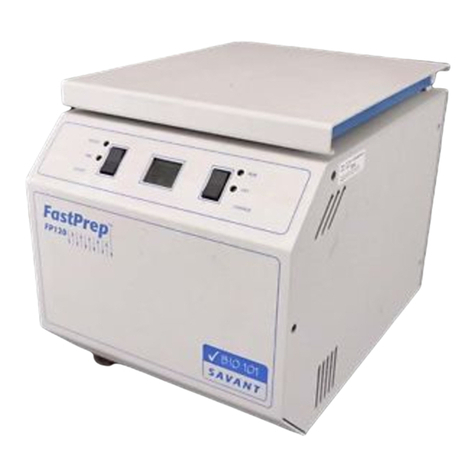
Thermo Savant
Thermo Savant FastPrep FP120 instruction manual

Agilent Technologies
Agilent Technologies 7694 manual
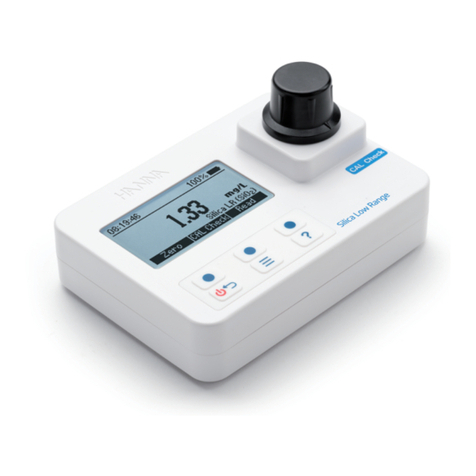
Hanna Instruments
Hanna Instruments HI97705 instruction manual
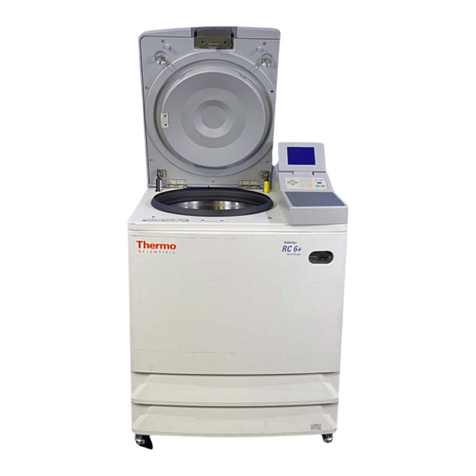
Thermo Scientific
Thermo Scientific Sorvall RC6 Plus instruction manual

Olympus
Olympus SZ2-STU1 instructions

Drucker Diagnostics
Drucker Diagnostics 642M Operator's manual
